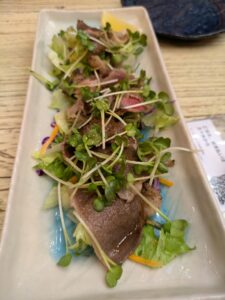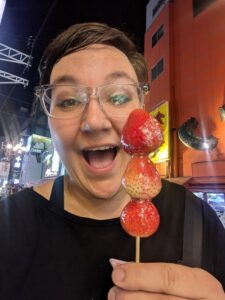Lessons Japan taught me about content localization strategy
Being a native English speaker and first-time visitor to the incredible country of Japan, I found several takeaways for creating content with translation in mind.
Plus, in this blog, you’ll find delicious pictures of world-class food. (Caution: may cause salivation and a desperate urge to buy a plane ticket. Or is that just me?)
I won’t lie. I was nervous.
Of course, I was also incredibly excited. But I’d heard from several friends and online sources that navigating public transit in Japan was complicated. Plus, my Japanese is limited to a few pleasantries such as hello, thank you, please, and most importantly, tasty. Nevertheless, my friend (also a native English speaker and first-time traveler to Japan) and I were determined to use public transit exclusively on this trip. Ergo our excitement and nerves.
Surprisingly, using public transit was much easier than we anticipated. It became one of our favorite things to do. A few factors within our control helped, specifically doing research in advance and using a suite of translation tools (where Google apps were undeniable winners for accuracy and functionality).
However, successfully navigating transit was primarily due to several initiatives that Japan has knocked out of the park:
- Japan’s massive and intricate transit system is well organized and implemented. Clear and strategic forethought is exhibited in every detail. It’s rare to experience even minor delays, and communication is proactive and consistent.
- Location names are phonetically spelled out in the Latin alphabet on almost every transit sign, often paired with English words such as bus, train, and so on, even in remote areas.
- Colors and icons are used to identify specific transit types (bullet trains, regular trains, subways, and more) and lines. When it wasn’t an option to follow the name of our destination, we could rely on following the unique color and icon pairing of our required transit line.
- Help was always nearby in the form of station attendants or machines that contacted station attendants. English translations were always available either through multilingual individuals or attendants using automated translation tools.
Lesson #1: Make content as universal as possible
Colors and icons weren’t the only universal symbols used to communicate concepts. Many restaurants provided images or plastic replicas of the entire menu so people could have a better understanding of what they were ordering. Some menus were exclusively written in Japanese, but we still had enough information to know what we wanted without knowing the language.
Whether it was for transit or food, I continually thought, “These systems were built with translation in mind.”
Whether it was for transit or food, I continually thought, “These systems were built with translation in mind.”
— Christine Cuellar
This lesson is so applicable to content creation. Are the terms, phrases, or examples you’re using specific to your region or country? Do you have a content localization strategy in place to help guide your content development? How can you create with translation in mind?
Lesson #2: Use unified terminology
Conversely, we ran into a few instances where localization may have been an afterthought. As Americans, we had to stop in a certain famous fast food restaurant with yellow arches. (Don’t hate—we had to try it at least once.)
A local friend recommended the Samurai Mac as the best Japanese McDonald’s dish. After confirming we had the name right, we moved on to our next city and gave it a try.
Sadly, the Samurai Mac wasn’t listed anywhere on the digital menu. We wondered if the burger was location-based, so maybe this area didn’t offer it. Instead, my friend ordered the Roasted Soy Sauce Double Thick Beef burger because it sounded good, and it wasn’t something we could get in the States.
I opted for the Shaka Shaka chicken with spicy red pepper dry seasoning for the same reasons, and I was NOT disappointed.
When our orders arrived, it turned out she had unknowingly ordered the very burger we were searching for!
Why wasn’t the product name the same on the screen and the wrapper? Who knows! Maybe there are variations of the product name in the source content. Perhaps alternative names aren’t identified as issues after translation. Or, it’s possible that other gaps led to inconsistent product names.
Whatever happened, as end users, my friend and I would have missed out on an anticipated experience with a known brand because localization wasn’t properly planned for or implemented. Luck (and my friend’s love of soy sauce) just randomly happened to save the day.
While this is an example with very low stakes (and delicious burger patties instead), the underlying lesson of using unified terminology is relevant in more serious situations. What if we were searching for a medical device? What if we needed to identify a critical part or process for heavy machinery?
Resources for kick-starting your content localization strategy
Even if your organization isn’t localizing content for other regions right now, you’ll likely do so as you expand into new markets.
These resources from our expert content localization strategists will help you get started:
- Accelerate global growth with a content localization strategy (podcast)
- Conquering content localization: strategies for success (podcast)
- Lost in translation? Create scalable content localization processes
- Switching to a different content management system (CMS) or component content management system (CCMS)? Replatforming with localization in mind
As promised, more food pictures
No, these don’t have anything to do with content localization strategy. The food was just delicious.

Miso ramen with melon soda from Tokyo.

Okonomiyaki from Hiroshima.

Fresh greens with thin-sliced Kobe beef from Hiroshima.

Takoyaki from Osaka.

Green matcha soft serve ice cream from Osaka.

Tanghulu (candied strawberries) from Osaka, then Tokyo. I enjoyed these many, many times.
Need help building a content localization strategy? Let’s talk!
"*" indicates required fields









